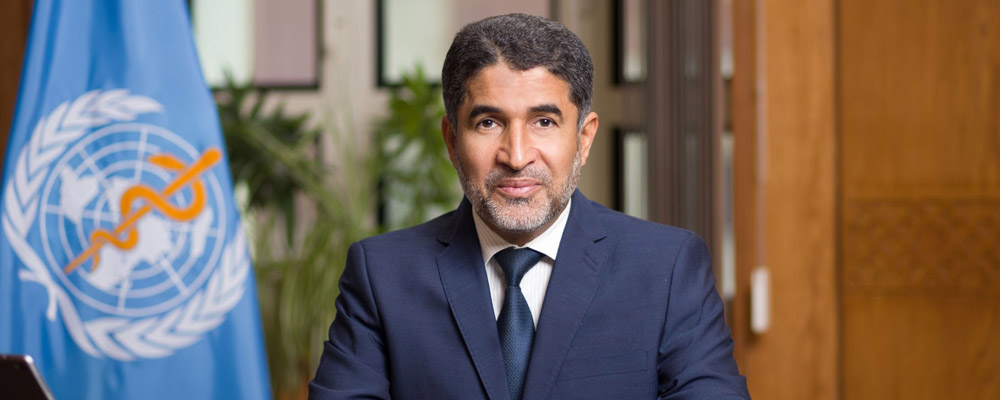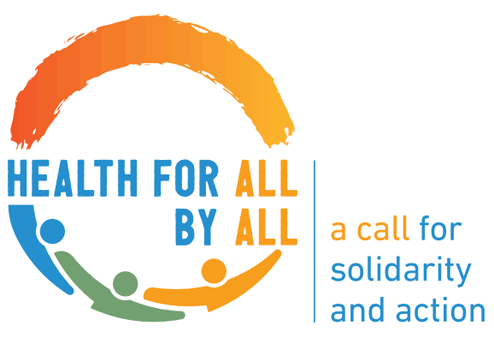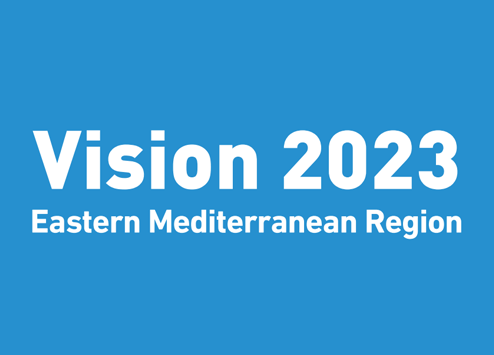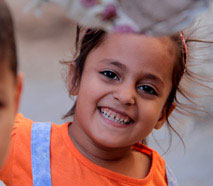Introduction

It was an important year for the Organization, both globally and in our Region.
On 25 May 2018, the Seventy-first World Health Assembly approved WHO’s Thirteenth General Programme of Work (GPW 13). This global strategy sets clear aims, encapsulated in our new mission statement – “promote health, keep the world safe, serve the vulnerable” – and reinforced by the strategic goals of ensuring that at least 1 billion more people benefit from universal health coverage, 1 billion more are protected from the consequences of health emergencies and 1 billion enjoy better health and well-being by 2023.
The adoption of GPW 13 coincided with my own appointment as WHO Regional Director for the Eastern Mediterranean. On starting my post in June 2018, I initiated a broad consultation to develop a new approach to guide WHO’s work in the Region for the coming five years.
The result was Vision 2023, our new vision for public health in the Region. Vision 2023 commits WHO to strive for “Health for All by All” in the Eastern Mediterranean Region, and identifies four strategic priorities: expanding universal health coverage, addressing health emergencies, promoting healthier populations and transforming WHO itself.


Most of the period covered by this report predates the introduction of GPW 13 and Vision 2023. Nonetheless, there were significant developments in relation to each of our strategic priorities. Let me highlight some key achievements – and some important challenges.
Expanding universal health coverage (UHC) is at the heart of everything we do and has been recognized as a top priority by our Member States in the Region. In Salalah, Oman, in September, health ministers reaffirmed their commitment by signing the UHC2030 Global Compact and issuing a landmark regional declaration.
Turning that commitment into reality entails action on many fronts, from improving health leadership and governance to developing better health systems, health information systems and health financing, as well as a lot of work to tackle both communicable and noncommunicable diseases.
A regional parliamentary forum for UHC and the regional chapter of the Health System Governance Collaborative both launched in 2018, as did a pioneering new WHO team to explore health system strengthening in emergencies, the Health Systems in Emergency Lab.
Meanwhile, WHO is also working to ensure that all health policies and practices are based on the soundest possible evidence by expanding the base of reliable data and research and enhancing countries’ capacity to use it. Core health indicator reporting rose by an impressive 15% on average in the period 2014–2018.
At a UN conference in September 2018, world leaders restated their pledge to cut deaths from noncommunicable diseases by a third. We will not meet that ambitious target in the Eastern Mediterranean Region at the current rate of progress. More effort is needed in all four areas of our regional framework for action: governance, surveillance, prevention and health care.
WHO has therefore been scaling up efforts to better support countries in preventing and managing cardiovascular diseases, cancer, diabetes and chronic respiratory diseases. The new “5x5 approach” endorsed at the high-level conference recognizes the importance of air pollution and mental health, and we look forward to building on our existing strong work on those issues.
UHC also means tackling the menace of communicable diseases. WHO works with countries to strengthen essential systems such as surveillance, public health laboratories and health services so that diseases such as HIV, hepatitis and tuberculosis can be detected and treated.
Even more important is prevention through comprehensive immunization and the interruption of transmission. The volume and complexity of emergencies in the Region is undermining efforts to ensure total vaccine coverage and surveillance, leading to the re-emergence of threats that had been receding. Most frustratingly, wild poliovirus is still circulating in two countries of the Region, Afghanistan and Pakistan, and threatens to spread more widely if it is not stamped out for good.
Addressing health emergencies is a critical priority in the Eastern Mediterranean Region. There are more people in need of humanitarian assistance and more forcibly displaced people here than in any other WHO region. Eight of our 22 countries faced emergencies in 2018, and another seven were directly or indirectly affected by them.
WHO worked energetically with our Member States and partners to deal with those emergencies. Our response was coordinated through our regional Emergency Operations Centre (EOC), which allows real-time information sharing and collective decision-making, while our operations and logistics hub in Dubai delivered essential medicines and other supplies to countries in the Region and beyond. More than 1462 metric tonnes of health supplies reached more than 4.5 million beneficiaries in 22 countries across three WHO regions.
There were 19 major outbreaks of 10 different diseases in our Region in 2018, including the world’s largest cholera outbreak in Yemen. Here, as elsewhere, WHO is working with partners to ensure an integrated response, from improving water and sanitation, raising awareness and rolling out vaccination to enhancing the surveillance, detection and treatment of cases. Experience shows that potentially devastating disease outbreaks can be contained through prompt and thorough action, but prevention is even better. A strategic framework is being developed to guide efforts to prevent and control emerging and epidemic-prone infectious diseases.
Progress in 2018 included, among many other things, the endorsement by our regional governing body, the Regional Committee for the Eastern Mediterranean, of a regional framework for action on preconception care and the development of a draft regional neonatal, child and adolescent health implementation framework, as well as extensive work to build country capacities.
Emergency preparation continued apace, focusing on helping our countries to implement the International Health Regulations (2005). Most countries in the Region have now undertaken joint external evaluation (JEE), and 12 so far have used JEE findings to help develop a national action plan for health security. There was also encouraging progress in developing cross-border security with the signing of the Khartoum Declaration on Sudan and Bordering Countries in November 2018.
Shockingly, all too often dedicated individuals – WHO staff and others – have to risk their lives to provide health care in emergency settings. There were 725 documented attacks on health workers in the Eastern Mediterranean Region in 2018, and 137 people were killed, making this the most dangerous WHO region for health workers. WHO is working with countries to prevent and mitigate attacks, but we need to see far more progress on this. The current situation is unacceptable.
Promoting health and well-being is central to WHO’s regional vision of Health for All by All. Our work on this includes encouraging governments to address the underlying causes of ill health and factor health concerns into all their policies, and we also support a range of actions to address disease risk factors and promote healthy lifestyles.
There were some welcome signs of high-level political commitment and leadership. September saw the launch of a Regional Forum for Road Safety Legislators; in October, Member States endorsed a resolution urging all Member States in the Region to institutionalize the Health in All Policies approach; and together with the United Nations System Staff College, we developed a course for ministries of health and WHO country offices to enhance policy-level understanding of health promotion.
Meanwhile, work to address risk factors continues. The fight against tobacco took another step forward with the adoption of a regional strategy on tobacco control, while action on nutrition included, among other things, a new framework for action on obesity prevention – to be followed in 2019, hopefully, by a comprehensive new regional nutrition strategy. In addition, the Regional Committee endorsed a regional framework for action on health and the environment to guide the next five years of work, and a recent organizational review of WHO’s Regional Centre for Environmental Health Action (CEHA) should mean we are better placed to support countries in implementing the framework.
Along with our three substantive public health priorities, WHO is also prioritizing internal reform. As I told the Regional Committee at our annual meeting in October 2018: “I am shaking the tree to let the dry leaves fall and remove the obstacles that hinder us from being a dynamic, agile Organization.”
With generous support from donors including the German Government and the Bill and Melinda Gates Foundation, we have begun a comprehensive review of our structure, resourcing and functions with the aim of optimizing our operational effectiveness and efficiency and maximizing impact at country level.
Functional reviews of country offices began in 2018, with reviews of Regional Office departments set to continue through to 2020. We are also working to develop a clear results management framework and a strong communications strategy.
WHO has much to do in the Eastern Mediterranean Region, but if we can synergize our efforts with those of our Member States and other partners, I am confident that there will be further progress to report next year.



